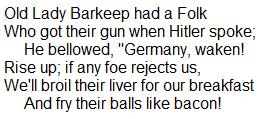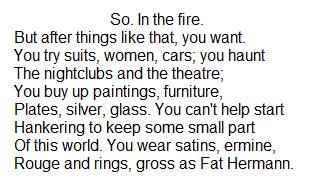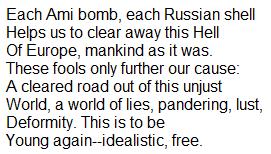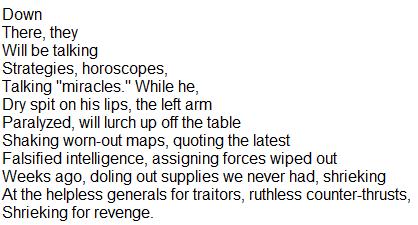The Führer Bunker: A Cycle of Poems in Progress by W. D. Snodgrass. BOA Editions, 1977.
The Fuehrer Bunker: The Complete Cycle by W. D. Snodgrass. BOA Editions, 1995.
As Reviewed By: J. S. Renau
In speaking of his ready-mades, Marcel Duchamp once remarked that “art is a habit-forming drug.” And so he limited his creation of ready-mades to a handful yearly, not wanting this mode of expression to become “contaminated.” Over and above the Dadaist pretense, I suppose there is something to the notion. After all, modes of expression–even formal verse patterns–can give out and lose their ability to convey much of anything resembling a provocative idea. Sometimes the torpor is due to the audience’s numbness; other times the artist loses his focus or fury after squeezing so many thoughts into, say, 14-line poems or bicycle wheels mounted onto kitchen stools. Take, for example, John Berryman’s 77 Dream Songs: a brilliant collection, tightly conceived and marvelously executed. But over 300 more Dream Songs would appear over time, watering down the project to the point that only a Berryman devotee or a masochist can finish the entire collection.
When W.D. Snodgrass first published The Führer Bunker in 1977, he added “A Cycle of Poems in Progress” as the volume’s subtitle, and sure enough, additional poems appeared irregularly in the quarterlies for another 18 years until the completed cycle was eventually published. The 1977 volume was heavily edited and supplemented by a bevy of new poems, yet much like Berryman’s Dream Songs, the final result is a prime example of why, sometimes, less is more. In fact, the complete cycle is so tired that it completely loses any sense of drama or movement. The 1977 volume includes 20 poems in a manageable 50+ pages. The poems are staged in the tidy period of one month, April 1 to May 1, 1945. The complete cycle covers the same one-month period, but runs to almost 200 pages and 90 poems. The newer lot of poems is not entirely bad; however, the sheer number of throwaways can try the patience of even the most willing of readers. On balance, the 1977 edition, despite its “in-progress” label, is a superior volume, a leaner and more compact reading experience.[private]
The volume is comprised of monologues spoken by leading figures of Nazi Germany from an underground bunker during the last days of the Reich. In the complete cycle, Snodgrass has added poems spoken by a “chorus” that at once recall and depart from the classical model. Snodgrass’s chorus is not so much the voice of convention or popular wisdom, but rather an indictment of the German people (after all, Hitler was democratically elected). The book commences with the chorus announcing:
The choral voice does maintain a certain consistency throughout the volume; it is satirical and often bawdy; its judgments are our judgments, and thus it participates in a moral order familiar to and endorsed by the reader. But the choral voice does not embody or miniaturize German (or Western European) society, thereby losing some of its ability to dramatize the tensions between the individual speakers and the society they inhabit. Fitting, that, given the realities of totalitarian fascism, its secret police squads, indoctrination programs, and brutal suppression of dissent.
In antiquity, the chorus was not only representative of society at large, but of conventional morality and habits of mind. In this regard, the chorus acted as a sort of organized nostalgia, albeit a highly relevant and functional one. By shifting the perspective of the chorus to the third-person (“Old Lady Barkeep”), its judgments are filtered in a curious manner. Judgments are made, but the choral voice itself is disenfranchised by what becomes either a self-indictment or the detachment of a third person. All of this I find interesting in the abstract, but it is window dressing, and the success or failure of The Führer Bunker obviously depends on the monologues themselves.
Snodgrass also imposed a topical order on the complete cycle that was absent in the 1977 volume. The poems are now sectioned off under headings, such as “Preparations” and “Identities.” These I find not at all helpful, for they only clarify and give order to rather obvious historical or chronological stages of the Reich’s final days. Each monologue already bears the date of its utterance; to add another system of order dependant upon chronology does not offer much to the reader and is more akin to the decision-making process of editors, not poets.
And then, of course, there are the additional monologues. What precisely motivated Snodgrass to devote so much of himself to the project is anyone’s guess, but it is clear that the complete volume is a further development of the themes presented in the 1977 volume. Developing themes is a habit of expository writing classes, not poetry necessarily. Economy is of equal, if not greater, importance, or as David Byrne once sang, “When I have nothing to say, my lips are sealed.” It’s not, of course, that Snodgrass has nothing to say, but that it was said in a much more concise and powerful form in the 1977 volume. If the monologues were linked by something other than chronology, perhaps then the complete cycle of poems would have been a necessary endeavor, but the individual monologues read as and are meant to be stand-alone items. The cycle, in this respect, is merely a collage of important, but ultimately replaceable parts.
* * *
Of course, it was the reaction to the 1977 “in-progress” installment of The Führer Bunker that produced such a wide range of opinions and emotions. The complete cycle did little to alter or mitigate the ire of those who found the 1977 volume in poor taste. Likewise, from the perspective of someone favorably disposed to the book, the finished volume also did little to enhance the project. But one thing is certain: few volumes of poetry since the Second World War have been as controversial as The Führer Bunker (Pound’s The Pisan Cantos comes to mind).
But despite the seeming absurdity of the book’s premise, The Führer Bunker is not buried in altogether alien turf. The humorist Alan Coren once entitled one of his volumes Golfing for Cats (the cover of which carried a black swastika) after his agent told him that the only guaranteed commercial successes in publishing were books about cats, golfing, and Nazis. The fact is that, for better or worse, the reading public is fascinated by Nazis (dead ones, to be sure).
Those commentators who worry about our collective mental health often debate what is gained from such assiduous scab picking, though it is obvious that the staying power of Nazi Germany can be explained largely by the fact that most every group, regardless of ideology or faith, can find a cautionary tale in the rise and fall of the Third Reich. And, like cautionary tales, the manner in which we speak of Nazis in mainstream discourse relies on a certain formulaic approach that usually serves to establish, if nothing else, the speaker’s rhetorical ethos. The Führer Bunker, however, subverts some key aspects of this formula, and much of the animus directed at the book can be understood in this context. In drawing the characters of those Nazis who populate The Führer Bunker, Snodgrass clarified his intentions and aims in a 1996 interview:
But there’s a more important reason why people might dislike The Führer Bunker…It’s comforting to believe that the Nazis were utterly different from the rest of us, so different that we can describe them as inhuman–or bestial or fiendish or whatever–and so different that any attempt to understand their behavior is bound to fail. The Führer Bunker assumes that this is false.
Part of Snodgrass’s strategy in The Führer Bunker is, as he suggested above, to establish a certain level of recognition between persona and reader. For the most part, this is accomplished by shrink-wrapping the personae in bourgeois values and tastes. American pop songs, love letters, domesticity, allusions to classical literature, and a taste for rich foods and fine spirits are all juxtaposed with Nazi historiography and the demonic nature of each character’s stated or implied actions–genocide, infanticide, and coprophagia, to name a few. This strategy finds its clearest and most powerful voices in the poems spoken by Eva Braun, Hitler’s mistress, and Joseph Goebbels, the Nazis’ propaganda minister. In Goebbels’s first poem (19 April, 1945), he reminisces about past love affairs while destroying documents and assorted memorabilia–official party documents, love letters, and the pictures of lovers–in his study. When he discovers an old picture of Lida Baarova, his favorite mistress, he is led to think about love and its attachments:
The self-pity, refinement, and highly developed sensibility (albeit a twisted one) could, in a different context, indicate a middle-aged man coming to terms with a crisis or the end of a failed enterprise. Such musings tug in the opposite direction that readers will want to go; after all, we’ve all loved and failed at love. However, the passage above is followed shortly thereafter by the kind of logic most readers readily associate with the Nazis:
That Goebbels had rarified tastes or a sentimental soft spot for one actress or another is meant to clash with the monstrous logic of the foregoing quotation–on what terms do we approach the persona of the poem? Obviously, for most of us, there is only one approach to Goebbels and the rest of the Nazis, for to approach them any other way (by way of literature or history) is to become, in some small way, complicit in their crimes. On a certain level, we are not ready for the Nazis to become literature. Far more comfortable is the notion that bad men, whether they wear a swastika or not, come only in the action-movie variety of villain with uncomplicatedly evil natures. But as literature, The Führer Bunker forces on the reader, even if only fleetingly, Goebbels the aesthete, Goebbels the lover, and Goebbels the armchair philosopher. Some critics object to the gesture on the grounds that such imaginings cannot make a man like Goebbels more evil, and that is certainly true, but it’s also not the point.
Snodgrass’s great contribution to American verse is his ability to create a “reflexive” poetry where the artifact of the poem is difficult to separate from the poet’s process of self-examination. Presumably, the reader must follow suit, and whereas The Führer Bunker is concerned, it is a mental exercise that many readers refuse to carry out. In this sense, The Führer Bunker is less about Nazis and more about Everyman’s potential for evil. Without deferring to disco-era reader-response criticism, there is something to be said for the reader’s expectations in encountering The Führer Bunker. And most of the bluster that passes for criticism concerning the volume ultimately says more about us than Snodgrass’s poetry. The dirty little trick of The Führer Bunker was in creating Nazis who resemble us, not to attenuate their sins, but to magnify ours. That this strategy flies in the face of the smug and the lazy, particularly 25 years after the book’s initial publication, is surely a good indication of its relevance and its ability to strike a nerve.
* * *
But poems must stand or fall as artifacts, too. On this point, The Führer Bunker does not display the consistency of great poems, but it has its moments. Magda Goebbels’s poem of 19 April, 1945, is as moving and well-conceived as any poem of the post-war period. Cast in the form of a series of villanelles, the monologue is spoken as Ms. Goebbels plans to murder her six children before taking her own life in the bunker. It begins:
How can you do the things you know you’ll do?–
One last act to bring back integrity.
I’ve got just one desire left: to be true.
You can’t pick how you’ll live. Our times will screw
Your poor last virtues from you, ruthlessly.
How can you do the things you know you’ll do?
My mother drove me on: get married to
Quandt. Rich. Kind enough. If elderly.
I’ve got just one desire left: to be true.
He turned me against Friedlander, the Jew–
My stepfather who’d raised me lovingly.
How can you do the things you know you’ll do?
The formal requirements of the poem–two rhymes and two refrains appearing at regular intervals–reinforce the inner struggle of the speaker as she weighs infanticide and ideology against her maternal instinct. Likewise, Joseph Goebbels’s monologues are fittingly reminiscent of Knüttelvers, a flexible German tetrameter couplet often found in satire, tragicomedy, and burlesque. Goebbels’s couplets are highly ordered and precise and function as the perfect vehicle for a propaganda minister, such as the following passage that concludes the 1977 volume:
The rest is silence. Left like sperm
In a stranger’s gut, waiting its term,
Each thought, each step lies; the roots spread.
They’ll believe in us when we’re dead.
When we took “Red Berlin” we found
We always worked best underground.
So; the vile body turns to spirit
That speaks soundlessly. They’ll hear it.
However, form and design are not always so happily married in the monologues throughout the volume. Hitler’s chief architect, Albert Speer, has poems in the form of spatials. The formal connection is clever, but the poems suffer from a lack of interesting language. Notably, these were among some of the most heavily edited poems appearing in the complete cycle, while the accentual-syllabic poems, particularly the aforementioned villanelles, were hardly touched. Perhaps Snodgrass could sense the weakness of Speer’s monologues. Perhaps the temptation to meddle with the more arbitrarily composed poems was too powerful to shake. Either way, the spatials are not particularly effective. One part commentary, one part situation report, Speer’s monologues never move beyond reportage, occasionally spiced up with the ghost of a first-hand detail:
And then, of course, there are Hitler’s monologues, which never reach the level of complexity of the volume’s better work. Snodgrass’s Hitler is too comic, too cartoonish to be believed.
In a volume of so many throwaways, it is fortunate that the stronger poems do not rely on their weaker siblings for coherence or order. Fortunate because the weaker poems do nothing to diminish the luster of the poems that work, and the poems that work–such as Magda Goebbels’s villanelles and Joseph Goebbels’s monologues–are absolutely brilliant. Still, it is somewhat mystifying that a poet of Snodgrass’s talent and stature would spend almost two decades working on a collection largely composed of throwaways (the best of the lot were finished in 1977). A little of Duchamp’s discipline would have gone a long way.[/private]









